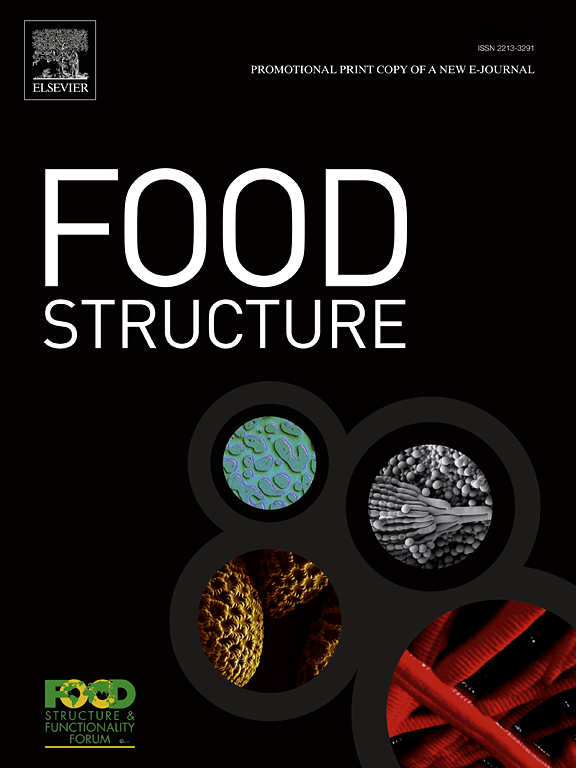食物的形状变化:设计的表面凹槽在豌豆蛋白产品的干燥和油炸条件下诱导受控的2D-3D-4D形状变化
IF 5.9
3区 农林科学
Q1 FOOD SCIENCE & TECHNOLOGY
引用次数: 0
摘要
变形食品是一种控制食品动态形状变化的新方法,通过增加包装负荷饱和度和减少对环境的影响,增强人类与食物的感官互动,促进可持续性。在此背景下,本研究旨在研究在受控干燥和油炸条件下豌豆蛋白基产品中凹槽诱导的形状变化。将一个豌豆分离蛋白面团(60:40,加水时的体积比)铺成5 mm的薄片,并使用3d打印聚合物模具冲压出1 mm、2 mm和3 mm的凹槽。样品在45°C、55°C和65°C下干燥240 min或在210°C下油炸30 sec。较高的干燥温度增加了水分干燥率,槽样达到7.5 公斤水/公斤固体。在65℃时,开槽样品的最大收缩率为0.60,孔隙率为0.51。凹槽较深的样品(d=3 mm)实现了可控的弯曲变形,弯曲角度为205 ± 2.23°,曲率为0.267 µ mm⁻¹ 。油炸也有明显的变形效果,向外弯曲度为154 ± 8.98°。较大的槽角(45°)导致加工过程中的扭转变形。扫描电镜成像显示了显著的表面修饰,而核磁共振分析表明,沟槽样品中的水分流失和微观结构转变加速,突出了表面沟槽在个性化食品设计和可持续性应用中实现受控形状转变的潜力。本文章由计算机程序翻译,如有差异,请以英文原文为准。
Shape morphing of food: Designed surface grooves induce controlled 2D-3D-4D shape changes in a pea protein-based product during drying and frying conditions
Morphing food is a novel approach to controlling dynamic shape change in food, enhancing human-food sensory interactions and fostering sustainability by increasing packaging load saturation and reducing environmental impacts. In this context, this study aimed to investigate groove-induced shape morphing in a pea protein-based product under controlled drying and frying conditions. A pea protein isolate dough (60:40, w/w with water) was sheeted to 5 mm and stamped with 1 mm, 2 mm, and 3 mm grooves using 3D-printed polymer molds. Samples were dried at 45 °C, 55 °C, and 65 °C for 240 min or fried at 210 °C for 30 sec. Higher drying temperatures increased moisture drying rates, with grooved samples reaching up to 7.5 kg water/kg solid. min. At 65 °C, grooved samples showed maximum shrinkage (0.60) and porosity (0.51). The deeper grooved samples (d=3 mm) achieved controlled bending morphing, with a bending angle of 205 ± 2.23° and curvature of 0.267 µ mm⁻¹ . Frying also induced distinct morphing effects, with outward bending of 154 ± 8.98°. Larger groove angles (45°) resulted in twisting morphing during processing. SEM imaging revealed notable surface modifications, while NMR analysis indicated accelerated water loss and microstructural transitions in grooved samples, highlighting the potential of surface grooving for achieving controlled shape transformations in personalised food design and sustainability applications.
求助全文
通过发布文献求助,成功后即可免费获取论文全文。
去求助
来源期刊

Food Structure-Netherlands
Chemical Engineering-Bioengineering
CiteScore
7.20
自引率
0.00%
发文量
48
期刊介绍:
Food Structure is the premier international forum devoted to the publication of high-quality original research on food structure. The focus of this journal is on food structure in the context of its relationship with molecular composition, processing and macroscopic properties (e.g., shelf stability, sensory properties, etc.). Manuscripts that only report qualitative findings and micrographs and that lack sound hypothesis-driven, quantitative structure-function research are not accepted. Significance of the research findings for the food science community and/or industry must also be highlighted.
 求助内容:
求助内容: 应助结果提醒方式:
应助结果提醒方式:


